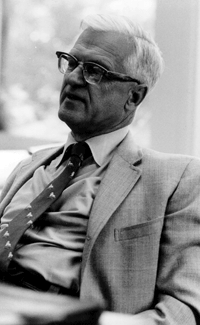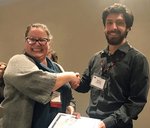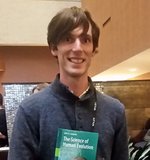
 This prize was created in honor of Sherwood L. Washburn (1911-2000). Born in Cambridge, Massachusetts, Washburn attended Groton School from 1926 to 1931 before going on to Harvard University where he received his B.A. and wrote a doctoral thesis on the osteology of Asian primates. He taught anatomy at Columbia University Medical School until 1947 when he moved to the University of Chicago to take a position in the Department of Anthropology. In 1958, he accepted a professorship in anthropology at the University of California, Berkeley, where he remained throughout the rest of his career. He was an active member of the American Association of Physical Anthropologists and also served as the editor of the American Journal of Physical Anthropology. Professor Washburn was a dedicated teacher who trained many productive students. His teaching and research were important in shaping the face of physical anthropological during the last half of the twentieth century. He was active in professional associations and served as the president of the American Association of Physical Anthropologists (1951-52) and the American Anthropological Association. Professor Washburn died on April 16, 2000.
This prize was created in honor of Sherwood L. Washburn (1911-2000). Born in Cambridge, Massachusetts, Washburn attended Groton School from 1926 to 1931 before going on to Harvard University where he received his B.A. and wrote a doctoral thesis on the osteology of Asian primates. He taught anatomy at Columbia University Medical School until 1947 when he moved to the University of Chicago to take a position in the Department of Anthropology. In 1958, he accepted a professorship in anthropology at the University of California, Berkeley, where he remained throughout the rest of his career. He was an active member of the American Association of Physical Anthropologists and also served as the editor of the American Journal of Physical Anthropology. Professor Washburn was a dedicated teacher who trained many productive students. His teaching and research were important in shaping the face of physical anthropological during the last half of the twentieth century. He was active in professional associations and served as the president of the American Association of Physical Anthropologists (1951-52) and the American Anthropological Association. Professor Washburn died on April 16, 2000.
Selected Works of Sherwood Washburn
Washburn SL ( 1942) Skeletal proportions of adult langurs and macaques. Human Biology 14:444-472.
Washburn SL (1951a) The analysis of primate evolution, with particular reference to the origin of man. Cold Spring Harbor Symposia of Quantitative Biology 15:67-78.
Washburn SL (1951 b) The new physical anthropology. Transactions of the New York Academy of Science 13 (2d ser.):298-304.
Washburn SL (1953) The strategy of physical anthropology. In: A.l. Kroeber (ed) Anthropology today: An encyclopedic inventory. Chicago: University of Chicago Press, pp. 714-727.
Washburn SL (editor) ( 1963) Classification and human evolution. New York: Viking Fund, 1963.
Washburn SL , and I. DeVore (1961) Social behavior of baboons and early man. In: S.l. Washburn (ed) The social life of early man. New York: Viking Fund, pp. 91-319.
Washburn SL , and D.A. Hamburg (1965) The study of primate behavior. In: I. DeVore (ed) Primate behavior: Field studies of monkeys and apes. New York: Holt, Rinehart & Winston, pp. 1-13.
Washburn SL (1968) The study of human evolution. Eugene: Oregon State System of Higher Education.
Washburn SL (1973) The promise of primatology. American Journal of Physical Anthropology 38:177-82.
Washburn SL (1978) The evolution of man. Scientific American 239:194-8, 201-2, 204 passim.
Washburn SL (1982) Human evolution. Perspectives in Biology and Medicine 25:583-602.
Washburn SL (1982) Evolution of a teacher. Annual Review of Anthropology 12:1-24.
Washburn SL (1984) A comment on Feldesman's analysis of the distal humerus. American Journal of Physical Anthropology 63:85-9.
Washburn SL (1985) Human evolution after Raymond Dart : twenty-third Raymond Dart Lecture delivered 28 January 1985. Johannesburg: Witwatersrand University Press for the Institute for the Study of Man in Africa.
Washburn SL, DeVore I, Jay PC, and Leakey LSB (1932) Sherwood L. Washburn papers, 1932-1996.
Washburn SL, and Dolhinow P (1968) Perspectives on human evolution. New York: Holt, Rinehart and Winston.
Washburn SL, Jay PC, and Lancaster JB (1965) Field studies of old world monkeys and apes. Science 150:1541-7.
Washburn SL, and McCown ER (1972) Evolution of human behavior. Social Biology 19:163-70.
Washburn SL, and McCown ER (1978) Human evolution : biosocial perspectives. Menlo Park, Calif.: Benjamin/Cummings Pub. Co.
Washburn SL, and Moore RE (1973) Ape into man; a study of human evolution. Boston: Little, Brown.
Washburn SL (1961) Social life of early man. Chicago: Aldine Publishing Co.
Washburn SL (1963) Classification and human evolution. Chicago: Aldine Pub. Co.
 William Aguado, Rutgers, The State University of New Jersey. Effective seed dispersal of an economically important plant resource by western chimpanzees at Fongoli, Senegal
William Aguado, Rutgers, The State University of New Jersey. Effective seed dispersal of an economically important plant resource by western chimpanzees at Fongoli, Senegal Jeffrey Spear, New York University. "Parallel evolution of suspensory locomotion in tree sloths and implications for understanding homoplasy in hominoids
Jeffrey Spear, New York University. "Parallel evolution of suspensory locomotion in tree sloths and implications for understanding homoplasy in hominoids
Copyright © 2024 American Association of Biological Anthropologists.
Site programming and administration: Ed Hagen, Department of Anthropology, Washington State University